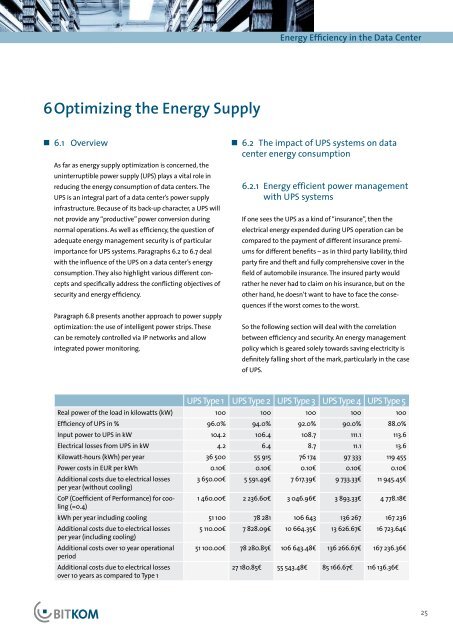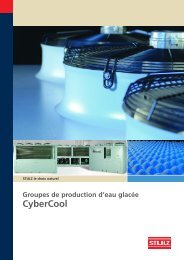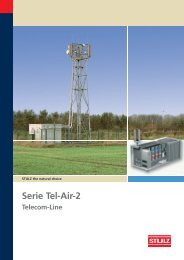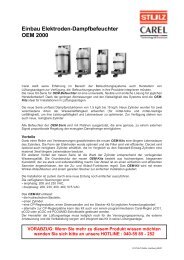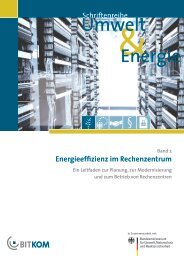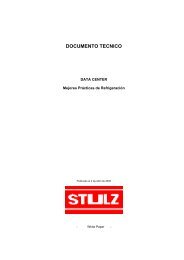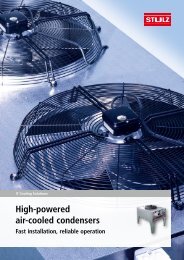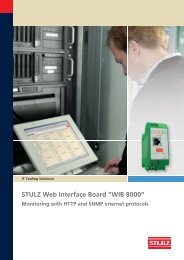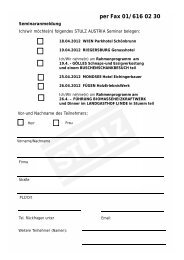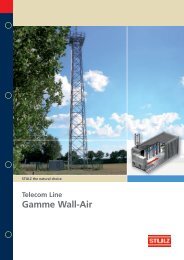Climate protection needs energy efficient data centers - Stulz GmbH
Climate protection needs energy efficient data centers - Stulz GmbH
Climate protection needs energy efficient data centers - Stulz GmbH
Create successful ePaper yourself
Turn your PDF publications into a flip-book with our unique Google optimized e-Paper software.
Energy Efficiency in the Data Center6 Optimizing the Energy Supply• 6.1 OverviewAs far as <strong>energy</strong> supply optimization is concerned, theuninterruptible power supply (UPS) plays a vital role inreducing the <strong>energy</strong> consumption of <strong>data</strong> <strong>centers</strong>. TheUPS is an integral part of a <strong>data</strong> center’s power supplyinfrastructure. Because of its back-up character, a UPS willnot provide any “productive” power conversion duringnormal operations. As well as efficiency, the question ofadequate <strong>energy</strong> management security is of particularimportance for UPS systems. Paragraphs 6.2 to 6.7 dealwith the influence of the UPS on a <strong>data</strong> center’s <strong>energy</strong>consumption. They also highlight various different conceptsand specifically address the conflicting objectives ofsecurity and <strong>energy</strong> efficiency.Paragraph 6.8 presents another approach to power supplyoptimization: the use of intelligent power strips. Thesecan be remotely controlled via IP networks and allowintegrated power monitoring.• 6.2 The impact of UPS systems on <strong>data</strong>center <strong>energy</strong> consumption6.2.1 Energy <strong>efficient</strong> power managementwith UPS systemsIf one sees the UPS as a kind of “insurance”, then theelectrical <strong>energy</strong> expended during UPS operation can becompared to the payment of different insurance premiumsfor different benefits – as in third party liability, thirdparty fire and theft and fully comprehensive cover in thefield of automobile insurance. The insured party wouldrather he never had to claim on his insurance, but on theother hand, he doesn’t want to have to face the consequencesif the worst comes to the worst.So the following section will deal with the correlationbetween efficiency and security. An <strong>energy</strong> managementpolicy which is geared solely towards saving electricity isdefinitely falling short of the mark, particularly in the caseof UPS.UPS Type 1 UPS Type 2 UPS Type 3 UPS Type 4 UPS Type 5Real power of the load in kilowatts (kW) 100 100 100 100 100Efficiency of UPS in % 96.0% 94.0% 92.0% 90.0% 88.0%Input power to UPS in kW 104.2 106.4 108.7 111.1 113.6Electrical losses from UPS in kW 4.2 6.4 8.7 11.1 13.6Kilowatt-hours (kWh) per year 36 500 55 915 76 174 97 333 119 455Power costs in EUR per kWh 0.10€ 0.10€ 0.10€ 0.10€ 0.10€Additional costs due to electrical losses 3 650.00€ 5 591.49€ 7 617.39€ 9 733.33€ 11 945.45€per year (without cooling)CoP (Co<strong>efficient</strong> of Performance) for cooling1 460.00€ 2 236.60€ 3 046.96€ 3 893.33€ 4 778.18€(=0.4)kWh per year including cooling 51 100 78 281 106 643 136 267 167 236Additional costs due to electrical losses 5 110.00€ 7 828.09€ 10 664.35€ 13 626.67€ 16 723.64€per year (including cooling)Additional costs over 10 year operational 51 100.00€ 78 280.85€ 106 643.48€ 136 266.67€ 167 236.36€periodAdditional costs due to electrical lossesover 10 years as compared to Type 127 180.85€ 55 543.48€ 85 166.67€ 116 136.36€25


